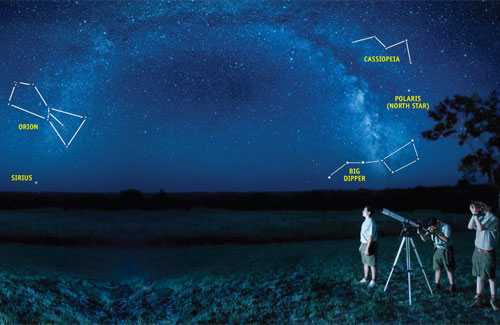Starry, Starry Night
By Karen Berger
Photographic illustration By John R. Fulton Jr. and Marcie Rodriguez
Fall and winter night skies offer great opportunities to view prominent stars, planets, and constellations, plus a meteor shower or two.
 Scouts Justin Aguilar, Tyler Estes, and Patrick Stone of Troop 1776, Plano, Tex., use Celestron's PowerSeeker 80 telescope and SkyScout to study the night sky. |
For millennia, stargazing has been more than recreation: By locating constellations, planets, and other celestial objects, people keep track of the seasons and navigate by night.
Fall and winter are good times for astronomical observers because night comes earlier, and cold nights make for starry skies. Knowing a few celestial landmarks can help you understand what you are seeing.
The North Star (also called Polaris) is the most reliable celestial navigation aid. While planets and constellations constantly change their position, the North Star remains solidly anchored in the north, just above the horizon.
How do you find it? First, find the Big Dipper. This large constellation is one of the most recognizable in the sky. It is made up of a three-star “handle” and a four-star “cup.”
Find the two stars that form the cup’s front end. Mentally measure the distance between the two stars and draw a line three times that distance, extending them on a straight line. Starting at the bottom front star of the cup, go to and through the top front star. That will lead you to the North Star.
Orion, another easy-to-recognize constellation, dominates the winter sky. Known as the hunter, it is readily identified by a row of three stars that make up Orion’s belt. Once you have located the belt, the rest of Orion’s body is easy to see (especially the shoulders and knees). There is a dagger that hangs down from his belt.
Cassiopeia was the Queen of Ethiopia in Greek mythology. Her constellation is a crown, although, admittedly, it looks more like a crooked capital letter “M” or “W” (depending on the time, the season, and which way you are standing).
Start with the North Star and the Big Dipper. From the middle star in the dipper’s handle, follow a straight line through the North Star and continue to the next group of stars, where you will find the telltale “M” or “W” shape of the queen’s crown.
Sirius, the dog star, is one of the brightest stars in the sky. Follow the line of stars in Orion’s belt down and behind him to the next bright star.
The Pleiades is a close star cluster— most people can see six without a telescope. Starting from Orion, follow the line of the belt upward (the opposite direction from Sirius), through the next constellation (which is Taurus, the bull). The Pleiades lie on the shoulder of Taurus.
In addition to stars, you will see planets, which are found traveling in an arc above Orion. Planets seem to have a steadier light than stars; they are said to “glow” rather than “twinkle.”
Venus and Jupiter are among the brightest objects in the sky; Mars and Saturn can also be very bright, depending on where they are in their orbit in relation to Earth. On a clear night, you will easily identify Mars by its distinctive orange-red color.
Watching a meteor shower is always exciting, as calls of “There’s one!” “There’ another one!” fill the air.
Meteor showers vary from year to year in intensity, and seeing them is dependent on clear, moonless skies. In autumn, the better known showers include the Leonids (Nov. 10-23) and the Orionids (Oct. 2-Nov. 7). A 2007 schedule can be found at http://www.amsmeteors.org/showers.html#X2007.
Karen Berger is the author of Backpacking and Hiking (BSA No. 34354, $20). Visit her Web site at www.hikerwriter.com.
Light Pollution Reduces Stargazing VisibilityLight pollution makes stargazing difficult in urban and suburban areas where streetlights and the dull haze of city lights obscure night skies. To see the best skies, find a hiking trail and leave towns and highways behind. If you are viewing from home, turn off all lights and position yourself as far away from other lights as possible. You will be amazed at the difference. The Boy Scouts of America has endorsed the concept of The International Dark-Sky Association of educating people about light pollution and providing strategies to reduce nighttime lighting. See http:// darkskycamping.googlepages.com/. |
Stargazing ToolsThe SkyScout Personal Planetarium ($399) is a handheld GPS-based device that identifies more than 6,000 stars, planets, and constellations. The user points the device at any object in the sky and clicks the target button; the SkyScout identifies it and provides astronomical information. www.celestron.com. Want to go the low-tech (and lower-cost) route? The Planisphere 2 ($29.95) makes it easy for beginners to find and identify 56 constellations (including the 12 zodiac signs) and the brighter stars. It refines the traditional star chart into a set of 20 clearly designed charts, each showing a small section of the sky. A teacher’s guide is available, making the Planisphere 2 an ideal tool for a group activity. www.planisphere2.com. Stikky Night Skies ($12). After following the simple instructions in this book, novice stargazers will be able to locate and identify six constellations, a planet, and the Milky Way. www.stikky.com. Binoculars or a telescope: A telescope or a pair of binoculars will reveal stars and features that are either not visible to the unaided eye or are difficult to make out clearly, such as the rings of Saturn and some of Jupiter’s moons. Other Web site resources are: |
September 2007 Table of Contents
Copyright © 2007 by the Boy Scouts of America. All rights thereunder reserved; anything appearing in Scouting magazine or on its Web site may not be reprinted either wholly or in part without written permission. Because of freedom given authors, opinions may not reflect official concurrence.